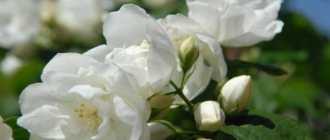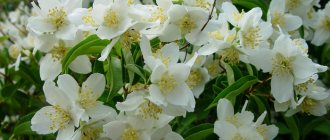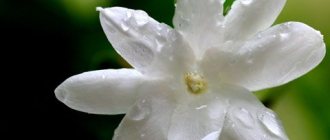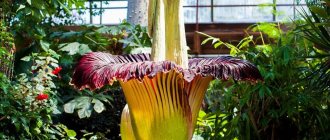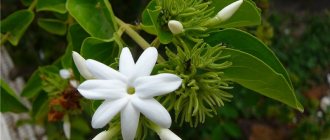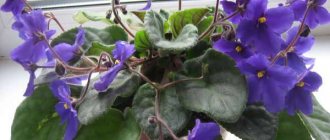The heady smell of jasmine in central Russia has not surprised anyone for a long time. But this capricious plant cannot grow in our cold weather - it freezes, and there is not enough sun for full flowering and development of the plant.
There will be craftsmen who will boast of classic jasmine in our conditions, but in most gardens it is not it that pleases the eye and sense of smell, but the much less whimsical shrub, the mock orange coronata, which grows calmly in Europe.
Briefly about the plant
Since mock orange saturates the garden with a wonderful aroma, gardeners often call it jasmine. The bush blooms with boiling white flowers.
Jasmine is an upright growing shrub that is covered with a gray crown, and in the fall sheds leaves, the color of which changes from green to yellow. Considering the height of the bush, it can be dwarf (up to 70 centimeters), medium or large (up to six meters). The leaves of the plant resemble the shape of an egg, slightly elongated and wide. The length of the leaves is 2 – 7 centimeters. Leaves can be double or semi-double. Jasmine blooms for two to three weeks. If you choose the right plant varieties, mock orange will bloom throughout the summer:
- in June, small-leaved varieties bloom, only one meter high with small leaves and beautiful bowing shoots. This mock orange smells like strawberries, so it attracts both people and insects;
- the thin-leaved variety of jasmine also blooms in the first rows. Its height is more than two meters;
- At the end of summer, varieties that have large leaves and dense crowns bloom.
Gardeners plant species and varietal plants on their territories, since mock oranges do not need special care and are not too whimsical. But for the winter, the bushes must be covered so that they do not disappear due to the cold winter weather.
Against the background of brick walls, you can plant a luxurious, vigorous, spreading bush. It will harmoniously and effectively decorate the largest garden.
Mock orange combines harmoniously with weigela, hydrangea, and lilac. It will stand out brightly among trees with bright leaves or an openwork crown. In autumn, jasmine with yellow leaves will go well with plants that have purple leaves (maple or hazel).
Small-leaved mock orange (Philadelphus microphyllus)
Small-leaved mock orange (Philadelphus microphyllus) is low, up to 1.5 m, its homeland is North America. In culture since 1883.
This species has thin graceful branches, during flowering covered with a mass of white flowers with a strawberry aroma.
Small-leaved mock orange
It blooms in June-July for about three weeks. The leaves are small, dark green.
About the coronary mock orange
Aureus coronata has yellowish or red-brown young shoots with dense leaves. The leaves of the bush are oval in shape, bare on top and pubescent along the veins below. Fragrant creamy-white flowers are collected in racemes.
The bush blooms for 22 days. Tolerates twenty-degree frosts. It is planted in parks and gardens.
Varieties of mock orange
There are many different varieties of mock orange. There are bushes that easily tolerate frost, and there are those that only love warm weather. The most popular varieties of mock orange:
- variety "Variegata" has original two-color leaves. They are green in the center and have light edging around the edges. The shrub blooms with snow-white flowers with cream centers. Jasmine has a thick, spreading crown. Grows up to two meters. Blooms in late spring, early summer for 25 days. Variegata loves sunny areas and fertile, moist soils. Fertilized with mineral fertilizers. For wintering, bushes need to be covered. Used to create hedges and beautiful landscape compositions;
- The “Snow Storm” variety has double snow-white flowers, bright green monochromatic leaves, and a strongly pronounced and pleasant aroma. It grows up to three meters and blooms in July for 25 days. It is recommended to prune shoots that are more than four years old so that the bush blooms profusely every year. This variety often suffers from aphids, so it needs to be treated with special protective agents;
- The “Pearl” variety has large snow-white, double flowers, plain bright green leaves, as well as curved red-brown branches. Grows up to one and a half meters. It blooms in mid-summer and blooms for two to three weeks. The variety is not afraid of frost. Grows best in fertilized sunny soils. They decorate front gardens and flower beds;
- the variety “Airborne” has flowers that resemble small bells of white or cream color. In the center they are decorated with yellow stamens. Blooms profusely and fragrantly. The bush has straight branches with green leaves. Reaches a height of two meters. It blooms for a month even in a shaded place. This variety withstands frost and is not afraid of disease. They decorate lawns and large flower beds;
- variety "Gordon" has white flowers with a weak aroma, large leaves with a glossy top. Reaches 4 – 6 meters in height, blooms at the end of June for 20 days. It is important to systematically prune outdated branches. Most often, this variety of jasmine is planted to provide shade from the scorching sun on a hot summer day;
- The Lemoina variety has a large crown, snow-white flowers that are collected in beautiful inflorescences, and large dark green and yellow leaves. The bush smells strong and cloying. Grows up to three meters. It blooms in mid-summer, sometimes again in the fall for 20 days. Lemoine blooms in the shade and withstands winter. It is used to decorate plots and create hedges;
- The “Komsomolets” variety is rich in white double flowers, a light, airy aroma, and graceful, elongated leaves. Grows up to two meters. Blooms for 20 days in midsummer. If the weather is too dry, it is important to water the bush regularly. Chubushnik can withstand even thirty-degree frost in winter. It is easy to care for, which is why gardeners often plant it in their gardens;
- the “Gnome” variety does not throw out buds for flowering. It grows low, has bright, small, jagged leaves and a dense crown. Tolerates winter. This type of mock orange is used to decorate borders, flower beds, and create landscape compositions. Since the branches are too thick, you can trim the bush to give it any shape;
- The “Alabaster” variety blooms with snow-white, semi-double flowers. The flowers that are inside are too small and thin. Each inflorescence contains 10 flowers. The bush has oval, green, medium-sized leaves, strong and spreading branches. Grows up to two meters. Blooms for 35 days in midsummer. It is important to prune the branches every year. Plant this variety of mock orange only in a sunny place, as even with slight shading, the bush may not bloom. If, if necessary, you feed the plant and water it regularly, you can get a hedge, as well as a single decoration for the area;
- the fluffy variety of mock orange has lower leaves that resemble airy cups. The flowers are odorless, but very beautifully shaped, which are collected in large inflorescences of 10 pieces. A plant of this variety blooms in July–August. The shrub grows up to three meters.
Planting and caring for mock orange
The process of planting mock orange is not difficult even for novice gardeners. Subtleties are associated with the choice of planting material and soil preparation. If you follow the rules, success is guaranteed.
Selection of seedlings
Saplings can be:
- purchased from a nursery (then pay attention to the generic name)
- grow it yourself (the previous section of the article is devoted to this)
- borrow from friends or neighbors
All these options have nuances and a number of common features.
Select a time to board. If you are not limited in time in the fall, buy seedlings as close as possible to the intended planting. In spring, time limits are important. You need to buy long before the seedlings have buds, and this moment is difficult to catch.
Use bushes that are visually healthy: without dry or damaged branches and rot. The roots are elastic, not overdried and without foreign inclusions, which may turn out to be, for example, parasite eggs.
It is necessary to exclude the presence of odors unusual for soil and roots. If you take seedlings in containers, carefully inspect the ground. Bushes sold in clean, moist soil have a better chance of establishing themselves.
From the point of view of pests, growing your own seedlings is preferable. But these shrubs will only produce the same variety. If, in order to diversify the garden, seedlings are taken from neighbors or friends, take a closer look at the donor’s plot in advance. Pay attention to the general condition of the plantings: are there any pests, wilting or damaged plants.
If you bring seedlings from outside, it is better to preventively treat the rhizomes with insecticidal preparations.
Landing place
Highly lit places are suitable for planting mock orange, as well as those in which there will be shade for a short period of time during the day. Permanent shade is not suitable for this plant: the bush will begin to stretch, the flowers will be crushed due to loss of strength, or flowering will stop altogether. The soil must be permeable to water, or drainage will have to be done.
The time for planting is chosen outside the growing season: early spring or late autumn. A couple of weeks before planting, a hole of 60x60 cm is dug for the bush. A reserve of time is needed so that the soil has time to settle. The hole may be a little shallower if the area has good drainage.
But since this is rare in our latitudes, 15 cm of the depth of each hole is allocated to expanded clay, broken brick, gravel and other materials for soil drainage. The remaining volume of the hole will be taken up by the soil mixture. The composition of this mixture for mock orange is as follows: 1 part humus, 2 parts sand and 3 parts earth.
The root collar of the seedling is placed flush with the surface of the earth, and the roots of the bush are distributed inside the hole. When everything is ready, the roots are additionally covered with soil mixture and watered at the rate of 20-30 liters of water heated in the sun per hole. Mulch the hole not immediately, but after 2-3 days. Both sawdust and peat are suitable for this.
If you need to plant more than one mock orange bush, the distance between them depends on the spreading nature of the bush’s crown. As a rule, 70-150 cm are left. To create a hedge, the distance is reduced to 50-70 cm.
Plant care
Caring for mock orange is no more difficult than planting it. The rules of agricultural technology only seem complicated: shrubs are much easier to care for than any other.
Watering
Mock orange is a moisture-loving plant, but drought is harmful to the bush. They recommend weekly watering of 20 liters of water under the root, and in case of drought, water daily, 1-2 buckets depending on the condition of the plant. If a shrub is suffering from drought, you will quickly understand it (its leaves will begin to wilt). The main thing here is not to miss the moment and not to confuse dryness with waterlogging, which is extremely difficult to do.
Mulching
Loosening and mulching are necessary, firstly, to reduce the frequency and volume of watering due to the destruction of soil capillaries through which moisture evaporates. Secondly, these practices reduce the number of weeds under the plant and retain nutrients in the soil for the mock orange. Loosen the soil regularly; this should be done after each watering.
Mulching is a less labor-intensive process that allows you to achieve the same results. It is better to choose dry peat or sawdust for this purpose. All you have to worry about using this technique is to replace the mulch if you notice that the mixture does not retain moisture.
Plant nutrition
Feeding is carried out twice a year. During the awakening period of plants, slurry is used for this. Manure is diluted in a ratio of 1:10, and fresh manure should not be used due to the content of viable pest eggs, spores of pathogenic fungi, and weed seeds. But the rotted one fits perfectly. When the bush fades, a second feeding is done - wood ash and potassium phosphate fertilizers.
Pruning branches
Helps ensure lush flowering, form the crown and provide the branches with sufficient light and air. In the spring, sanitary pruning is carried out: damaged and dried branches are removed, as well as improperly growing shoots: for example, those that are wrapped inside the bush.
Such shoots will not add decorative value to the area, but the plant will have to spend extra energy on them. In addition, such branches shade the crown, and mock orange is sensitive to light.
After flowering ends, young shoots are cut off. Thanks to this, every year there will be more such shoots, and flowering will become more magnificent. In addition, it helps the bush keep its shape.
Anti-aging pruning is carried out periodically: almost all shoots are cut out, leaving only the best. But their length is no more than 30 cm.
Price and place of purchase of mock orange
Since garden jasmine is most often propagated by green cuttings, it can be found on sale in the form of seeds.
Some exquisite varieties of mock orange cost up to 500 rubles, but the simplest ones can be bought for only 30 rubles.
You can buy jasmine bushes in different colors with different shapes of flowers and leaves. You can buy them at the market, in a large hypermarket, in small flower shops, in departments with seeds.
Now you know how mock orange grows and what types there are. It is important to plant it correctly and care for it regularly. If you plant several different types of jasmine on your site, you can watch it bloom throughout the warm season.

